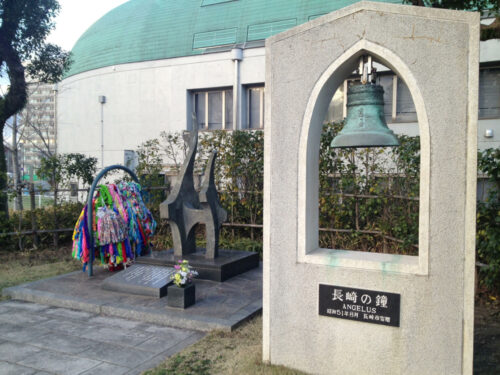Kokura was one of the targets chosen for the atomic bombings of Japan in 1945 but miraculously escaped the terrible devastation in the final days of World War II. (BBC NEWS MUNDO)
At 9:45 a.m. on August 9, the B-29 “Boxcar” carrying the plutonium bomb “Fatman” arrived over Kokura. “Fat Man” was a completely different bomb, far more powerful than the uranium bomb “Little Boy” dropped on Hiroshima.

Atomic Bomb above Kokura on the morning of August 9th, 1945
from [War’s End: An Eyewitness Account of America’s Last Atomic Mission/Charles W. Sweeney, James A. Antonucci, Marion K. Antonucci ]
Kokura lay ahead. Jim Van Pelt had picked it up on his radar screen a few minutes earlier. It was 9:45 A.M. The skies were still hazy, as reported earlier, but they were now mixed with broken clouds.
As we arrived at the IP, some landmarks were reasonably visible-the river, buildings, even streets and parks-so we thought here was a good chance to sight the target, the Kokura arsenal.
I started our bomb run when Beahan suddenly yelled, “I can’t see it! I can’t see it! There’s smoke obscuring the target.” The fires resulting from the bombing of Yawata the night before were still burning out of control, and heavy smoke was being lifted across Kokura by winds that had shifted direction since George Marquart had radioed his weather report.
As we bore in on the aiming point, Beahan repeated, “I can’t see it!” The great Kokura arsenal was safely hidden by the smoke and haze.
I yelled into my intercom, “No drop. Repeat, no drop.”
I banked the airplane sharply to the left and swung around to the south to begin a return approach to the IP. Flak bursts started all around us—to the left, ahead, to the right, and behind us.
A moment later tail gunner Pappy Dehart yelled, “Flak! Wide but altitude is perfect.” Everyone saw it.
“Roger that, Pappy,” I replied. They were crawling the flak up toward us as they tried to zero in on our airplane. I was now doing something a bomber pilot rarely, if ever, does— making a second run on a target. Second runs gave antiaircraft guns second chances.
I changed my altitude to 31,000 feet to try to confuse the enemy flak fusing.
As I proceeded toward the aiming point, Pappy broke in again. “This damn flak is right on our tail and getting closer.” His voice now sounded a note of panic.
“Forget it, Pappy. We’re on a bomb run,” I said evenly, trying to keep my attention on the approach to the aiming point.
I waited for Beahan’s signal that he could see the target. I hoped he had picked it up through a break in the smoke and haze. I hoped we could catch a break on this mission.
“I can’t see it!” he yelled again.
I wheeled into another steep turn as I barked, “No drop. Repeat, no drop.”
Ed Buckley, our radar operator, reported, “Major, Jap Zeros coming up.
Looks like about ten.”
I decided to take us up another 1,000 feet to try to throw the antiaircraft gunners off again, and then approach from a different angle. Maybe from a different angle we might have a chance of finding a hole in the cover.
Beahan and Van Pelt were frantically calculating the run approach data.
The bursts of flak were breaking very close to the airplane, causing it to jump.
The third run was no more successful than the first two. The aiming point was still obscured. Kuharek reported that our fuel situation was very critical. We had enough to get to our secondary target, Nagasaki, and make one run. But we wouldn’t make it back to Okinawa, the closest American base. We would fall short by about fifty miles.
Ed Buckley broke in over the intercom,”Fighters below and climbing to meet us.”
Jake Beser, who was monitoring Japanese radio frequencies, confirmed increased activity on the Japanese fighter-director bands.
I wasn’t as concerned about the Zeros as I was about the flak. Like horseshoes and grenades, close might be good enough if a burst caught us just right. If we hung around any longer, it would only be a matter of time.
Our gunner, Ray Gallagher, muttered into his intercom, “Let’s get the hell out of here.” Abe Spitzer, our radio operator, kept saying, “What about Nagasaki?
What about Nagasaki?”
“Cut the chatter,” I ordered sharply.
I again banked sharply to set us on a southerly direction toward our secondary target.
A replica of the Nagasaki Bell, a gift from Nagasaki-city, located in Katsuyama Park, where the Kokura Army Arsenal used to be. A memorial service is held each year on August 9.

In 1942, the United States’ atomic bomb development program (Manhattan Project) began. In April 1945, following President Roosevelt’s death, Vice President Harry S. Truman became President of the United States. On July 16, 1945, humanity’s first nuclear test (Trinity test) was conducted in New Mexico, USA. Then, in August, atomic bombs were dropped on Hiroshima and Nagasaki.
In 2012, President Truman’s grandson, Clifton Truman Daniel, visited Hiroshima and Nagasaki for peace ceremonies. It was the first time for members of the Truman family to participate in a peace ceremony after the atomic bomb was dropped.